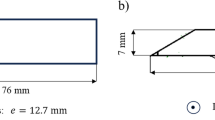Abstract
The paper reports on the modeling and respective experimental validation for the formation of the machined subsurface layer in turning with nose-radiused and round tools. An experimental work on the mechanisms of work-hardening of the machined surface and related wear of the cutting tools was conducted for high-speed turning of aged Inconel 718 with whisker-reinforced alumina tools. The model shows that multiple deformations of the machined surface occur when machining with small feeds and tools with large nose radius, thus changing the mechanics of surface formation. Experimental results confirm the localized increase in subsurface hardness in the vicinity of the tool tip. The variation in the degree of work-hardening and the extent of the area affected by it fully agree with the predictions of the model. The model also shows that a significant part of the cutting tool may cut through the extra work-hardened material. Tool wear tests show that the local increase in workpiece hardness results in a localized increase in the wear rate of the cutting tools.
Similar content being viewed by others
References
Schwach DW, Guo YB (2006) A fundamental study on the impact of surface integrity by hard turning on rolling contact fatigue. Int J Fatigue 28:1838–1844
Ghosh S, Kain V (2010) Microstructural changes in AISI 304L stainless steel due to surface machining: effect on its susceptibility to chloride stress corrosion cracking. J Nucl Mater 403:62–67
Kwong J, Axinte DA, Withers PJ (2009) The sensitivity of Ni-based superalloy to hole making operations: influence of process parameters on subsurface damage and residual stresses. J Mater Process Technol 209:3968–3977
Kortabarria A, Arrazola PJ, Ostolaza K (2013) Multi revolution finite element model to predict machining induced residual stresses in Inconel 718. Procedia CIRP 8:111–116
Guo YB, Liu CR (2000) Residual stress formation mechanism and its control by sequential cuts. Trans NAMRI/SME 28:179–184
Schulze V, Osterried J, Strauß T (2011) FE analysis on the influence of sequential cuts on component conditions for different machining strategies. Procedia Eng 19:318–323
Byrne G (1992) A new approach to the theoretical analysis of surface generation mechanisms in machining. Ann CIRP 41:67–70
Valiorgue F, Rech J, Hamdi H, Gilles P, Bergheau JM (2012) 3D modeling of residual stresses induced in finish turning of an AISI304L stainless steel. Int J Mach Tools Manuf 53:77–90
Mondelin A, Valiorgue F, Rech J, Coret M, Feulvarch E (2012) Hybrid model for the prediction of residual stresses induced by 15-5PH steel turning. Int J Mech Sci 58:69–85
Chandrasekaran H, Johansson JO (1994) Chip flow and notch wear mechanisms during the machining of high austenitic stainless steels. Ann CIRP 43:101–105
Bushlya V, Zhou JM, Avdovic P, Ståhl J-E (2013) Wear mechanisms of silicon carbide-whisker-reinforced alumina (Al2O3-SiCw) cutting tools when high-speed machining aged Alloy 718. Int J Adv Manuf Technol 68:1083–1093
Dolinšek S (2003) Work-hardening in the drilling of austenitic stainless steels. J Mater Process Technol 133:63–70
Pereira MJ, Bradley AL (2001) Effects of heat treatment on the ballistic impact properties of Inconel 718 for jet engine fan containment applications. Int J Impact Eng 25:715–733
Ellis J, Kirk R, Barrow G (1969) The development of a quick-stop device for metal cutting research. Int J Mach Tool Des Res 9:321–339
Zhou JM, Bushlya V, Peng RL, Johansson S, Avdovic P, Stahl J-E (2011) Effects of tool wear on subsurface deformation of nickelbased superalloy. Procedia Eng 19:407–413
Liu CR, Barash MM (1976) Mechanical state of the sublayer of a surface generated by chip-removal process – 1. Cutting with a sharp tool. J Eng Ind Trans ASME 98:1192–1201
Yan W, Fang L, Sun K, Xu Y (2007) Effect of surface work hardening on wear behavior of Hadfield steel. Mater Sci Eng A 460:542–549
Papshev DD (1978) Finishing operations by surface plastic deformation. Mashinostroenie, Moscow
International Standard Organization (1982) Basic quantities in cutting and grinding, part 1: geometry of the active part of cutting tools. ISO 3002/1-1982 (E)
Durazo-Cardenas I, Shore P, Luo X, Jacklin T, Impey SA, Cox A (2007) 3D characterisation of tool wear whilst diamond turning silicon. Wear 262:340–349
Lane BM, Shi M, Dow TA, Scattergood R (2010) Diamond tool wear when machining Al6061 and 1215 steel. Wear 268:1434–1441
Khruschov MM (1974) Principles of abrasive wear. Wear 28:69–88
Krell A, Bakun OV (1986) High-temperature hardness of Al2O3-base ceramics. Acta Metall 34:1315–1319
Kitagawa T, Kubo A, Maekawa K (1997) Temperature and wear of cutting tools in high-speed machining of Inconel 718 and Ti-6Al-6V-2Sn. Wear 202:142–148
Bushlya V, Zhou JM, Avdovic P, Stahl J-E (2013) Performance and wear mechanisms of whisker-reinforced alumina, coated and uncoated PCBN tools when high-speed turning aged Inconel 718. Int J Adv Manuf Technol 66:2013–2021
Author information
Authors and Affiliations
Corresponding author
Rights and permissions
About this article
Cite this article
Bushlya, V., Zhou, J. & Ståhl, JE. Modeling and experimentation on multistage work-hardening mechanism in machining with nose-radiused tools and its influence on machined subsurface quality and tool wear. Int J Adv Manuf Technol 73, 545–555 (2014). https://doi.org/10.1007/s00170-014-5837-0
Received:
Accepted:
Published:
Issue Date:
DOI: https://doi.org/10.1007/s00170-014-5837-0




